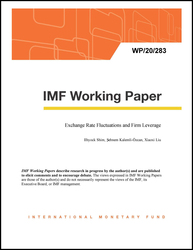
Exchange Rate Fluctuations and Firm Leverage
Exchange Rate Fluctuations and Firm Leverage
READ MORE...
Volume/Issue:
Volume 2020
Issue 283
Publication date: December 2020
ISBN: 9781513560946
$18.00
Add to Cart by clicking price of the language and format you'd like to purchase
Available Languages and Formats
| English |
Prices in red indicate formats that are not yet available but are forthcoming.
Topics covered in this book
This title contains information about the following subjects.
Click on a subject if you would like to see other titles with the same subjects.
Investments and Securities-General , Money and Monetary Policy , COVID-19 , Capital Flows , Exchange Rates , FX Borrowing , Firm Leverage , WP , FX debt , debt share , FX bond , government FX , FX loan
Summary
We quantify the effect of exchange rate fluctuations on firm leverage. When home currency appreciates, firms who hold foreign currency debt and local currency assets observe higher net worth as appreciation lowers the value of their foreign currency debt. These firms can borrow more as a result and increase their leverage. When home currency depreciates, the reverse happens as firms have to de-lever with a negative shock to their balance sheets. Using firm-level data for leverage from 10 emerging market economies during the period from 2002 to 2015, we show that firms operating in countries whose non-financial sectors hold more of the debt in foreign currency, increase (decrease) their leverage relatively more after home currency appreciations (depreciations). Combining the leverage data with firm-level FX debt data for 4 emerging market countries, we further show that our results hold at the most granular level. Our quantitative results are asymmetric: the effects of depre-ciations, that are generally associated with sudden stops, are quantitatively larger than those of appreciations, which take place at a slower pace over time during capital inflow episodes. As our exercise compares depreciations and appreciations of similar size, these results are suggestive of financial frictions being more binding during depreciations than a possible relaxation of such frictions during appreciations.
Copyright © 2010 - 2024
Powered by:
AIDC



